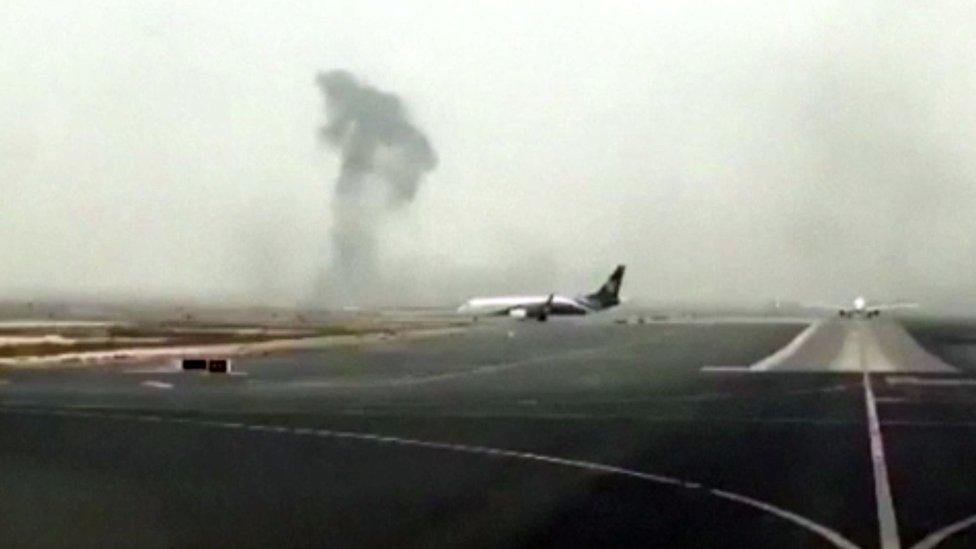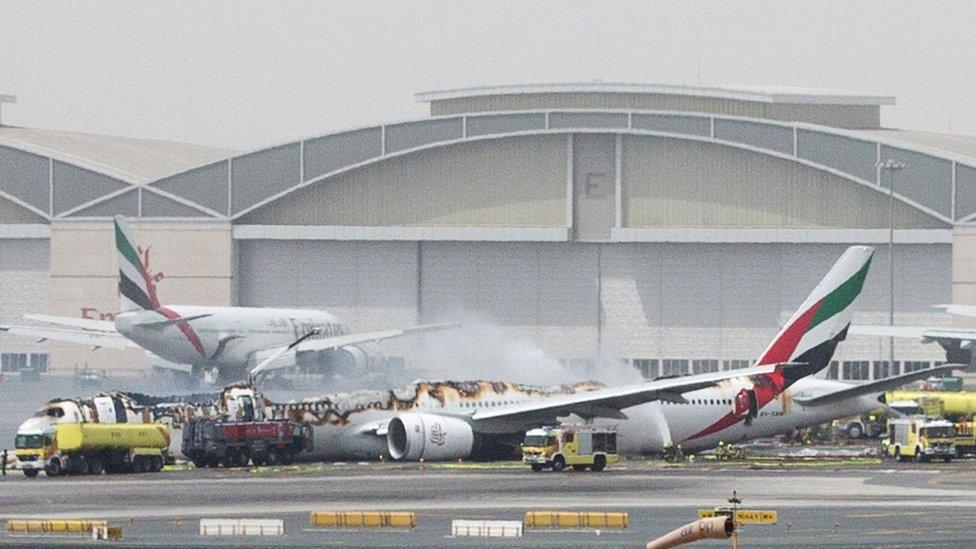Why do people grab their bags after a plane crash?
- Published

"Jump! Jump! Jump! Leave your bags behind. Jump and slide. Jump and slide!"
You can hear the anxiety in the flight attendant's voice as she tries to herd passengers off the Emirates Airline Boeing 777-300 that crash-landed at Dubai International Airport on Wednesday.
She realises that they are still in mortal danger, yet many of the people on board are wasting time grabbing bags from the overhead lockers.
A video shared on WhatsApp shows the panic on board the Emirates plane
At around 36 seconds into a longer version of the video, external posted on Twitter, it appears someone is talking about getting their laptop.
It's not so hard to understand why people do it. Without warning, their run-of-the-mill landing has just turned into a real-life drama.
The plane has belly-flopped, wheelless, on to the tarmac, skidding and spinning to a halt. It must be impossible to grasp what's going on and we're programmed to grab our wallet, passport, phone and house keys. Who can honestly say how any of us would react under that kind of stress?
But thank goodness the Emirates' crew followed their training so well and shouted at people to leave their bags behind.
The 90-second rule
Aircraft makers have to show that they can clear a plane within 90 seconds, using only half the exits - and for good reason.

All 300 people on board were able to escape from the burning aircraft, but a firefighter was killed tackling the blaze
"Studies show that the likelihood of a cabin being consumed by fire increases significantly after 90 seconds," aviation expert Ashley Nunes told me.
"But those evacuation tests don't account for people trying to take their luggage with them."
One minute, 23 seconds into the longer video of the evacuation, a passenger pans the camera over to film the engine fire. In your head you're screaming at them to get away! Part of the aircraft did actually explode not long afterwards.
The efficiency with which the crew cleared the cabin undoubtedly saved lives.
"We are beginning to see a pattern - when there are crashes, people take their luggage," Ashley Nunes says.
In September last year a British Airways plane caught fire on the runway in Las Vegas. You can see in the report from the time that in the rush to get off, some passengers have still taken their bags with them.
In July 2013 an Asiana plane crash-landed in San Francisco. Again, the photos show that passengers have grabbed their bags during the evacuation.
"The key to keeping people safe is speed - getting your bag slows things down," Mr Nunes says.
"These sorts of crashes are highly combustible and highly emotional. You've got people fearing for their lives and trying to get off the plane, but they can't because someone is tinkering with their luggage.
"That could create conflict. A laptop or piece of luggage with a sharp edge could also, potentially, puncture the inflatable escape slide."
So why do people do it?
"There are lots of psychologists with opinions but no controlled studies of the phenomenon. You can't recreate it in a lab setting because you can't put people in a life-or-death situation," Mr Nunes adds.

The aircraft's fuselage was extensively damaged
"People may just be used to getting their bag when a plane lands and it seems to be common no matter what part of the world you are from. These accidents included lots of people from all over Asia and the UK - they all did the same thing."
Should people film it?
You might be thinking that someone shouldn't be filming during an emergency. That just like grabbing a bag, it could potentially slow things down and put lives at risk. And you might be right. But this piece of footage could have a very positive effect on safety.
I've no doubt investigators will study it to see how people coped with a real drama compared to a practice drill. They may learn invaluable safety lessons for the future.
Looking at the footage, it appears that some people are instinctively grabbing the oxygen masks, for example. Why?
As far as I can make out, the person who shot the footage was on the tarmac 80 seconds or so after they began filming.
The blaze became so fierce it claimed the life of a firefighter, yet all the passengers and crew managed to get off safely. The 90-second rule seems to have saved many lives.
- Published3 August 2016
